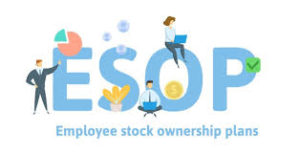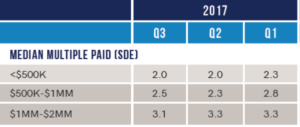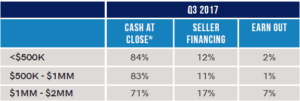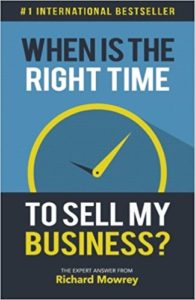Can I Sell My Business (C Corp Stock) Tax Free?
In some cases yes! Congress has long recognized that small businesses investment is an important driver of the U.S. economy. Back in 1993, to encourage capital investment in small businesses, they created a rule that eliminates federal income tax on some (later revised to all) of the gain on the sale of certain C Corporation stock issued after August 10, 1993. This article introduces the Qualified Small Business Stock (“QSBS”) tax break for business owners who are contemplating a future sale.
QSBS Requirements
To qualify for this tax break, your stock has to be deemed Qualified Small Business Stock per Internal Revenue Code Sec. 1202. Here’s a summary of 1202’s requirements:
- The business must be a domestic C Corporation
- Is a small business, defined as assets of less than $50 million
- The stock was issued after 8/10/1993*
- The stock was acquired at original issuance
- The stock has been held for 5 years or more at the time of sale
- The business is NOT engaged in professional services that are dependent on the reputation or skill of one or more employees, financial services, farming, mining or resource extraction, hotels, restaurants or other similar businesses
*Depending on the issue date of the stock, 50%, 75% or 100% of the gain (up to $10 million) may be excluded from federal income tax. The gain exclusion is 50% (subject to a 7% Alternative Minimum Tax (“AMT”) add-back) for stock acquired between August 11, 1993 and February 17, 2009. Stock acquired between February 18, 2009 and September 27, 2010 is eligible for 75% gain exclusion (subject to 7% AMT add-back), and stock acquired after September 27, 2010 receives a 100% exclusion, without an AMT add-back.
Andersen Tax offers a more complete list of QSBS requirements.
The QSBS tax break was made permanent by the PATH Act (Protecting Americans from Tax Hikes Act) of 2015. In case you’re wondering, the recent Tax Cuts and Jobs Act of 2017 did not alter QSBS rules, but the reduction of the federal corporate tax rate to 21% affects the magnitude of the QSBS benefit relative to a sale of assets. It is my understanding that California’s Franchise Tax Board no longer allows an exclusion on the gain of QSBS.
M&A Perspective
When a C corporation sells its assets rather than its stock, Sec. 1202 doesn’t exclude the gains that occur inside the corporation. So, even if you hold QSBS stock, you may not be able to get off tax free.
Acquirers of private businesses generally prefer to buy assets, not stock. For buyers, buying assets reduces their future tax bills, improves their cash flow, and reduces potential legal liabilities. When asked to buy stock and forgo these benefits, buyers usually expect to negotiate a meaningful price discount. However, given the magnitude of the QSBS tax break, especially when eligible for 100% exclusion, a seller of QSBS could give a buyer a significant price discount and still come out well ahead (relative to selling assets).
Fortunately, the reduction in the corporate tax rate to a flat 21% under the Tax Cuts and Jobs Act of 2017 makes a C Corp asset sale more palatable. The corporation will have to pay 21% on the gains, but the shareholder, when they receive the remaining sale proceeds through a liquidating dividend, can use Sec. 1202 to avoid tax on that cash. The overall tax effect is closer to that of an asset sale by an S Corp or LLC.
Do you have QSBS?
The prospect of selling qualified small business stock is compelling; however determining whether your C-Corp stock qualifies as QSBS and claiming this benefit can be tricky. Work with a CPA or tax advisor who is well-versed in QSBS requirements and who can calculate and compare your after tax proceeds under various deal structures. For another slick C-Corp tax maneuver, see my blog on personal goodwill.
If you intend to sell your business some day, please be aware that tax minimization strategies can have a big impact on how much money goes into your pocket. Some strategies can take 5 years to implement, so get your M&A and tax advisor involved early on.
* * *
Exit Strategies Group’s M&A advisors are dedicated to staying abreast of tax minimization strategies for our business sale, merger and acquisition clients. Al Statz, founder and CEO of Exit Strategies Group, is based in Sonoma County California and works with lower middle market companies throughout the U.S. For further information on this subject or to discuss selling a company, contact Al at alstatz@exitstrategiesgroup.com or 707-781-8580.


 Option 2. Sell to Other Shareholders
Option 2. Sell to Other Shareholders Owner Attributes
Owner Attributes


 I was recently talking with a business owner who is considering selling his California company. He had found my contact information online, and while he was interested in getting started, he really didn’t know how to evaluate a business broker’s credentials for a sale engagement. Sellers are often unsure what questions to ask. For this reason, I like to spend 15 minutes to share my relevant M&A experience, my career history, our firm’s processes and resources, and our capacity to get a deal done for the prospective client. In this blog post, I’ll focus on pertinent questions that a seller should ask when interviewing a prospective business broker or M&A intermediary.
I was recently talking with a business owner who is considering selling his California company. He had found my contact information online, and while he was interested in getting started, he really didn’t know how to evaluate a business broker’s credentials for a sale engagement. Sellers are often unsure what questions to ask. For this reason, I like to spend 15 minutes to share my relevant M&A experience, my career history, our firm’s processes and resources, and our capacity to get a deal done for the prospective client. In this blog post, I’ll focus on pertinent questions that a seller should ask when interviewing a prospective business broker or M&A intermediary.


